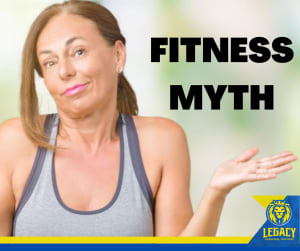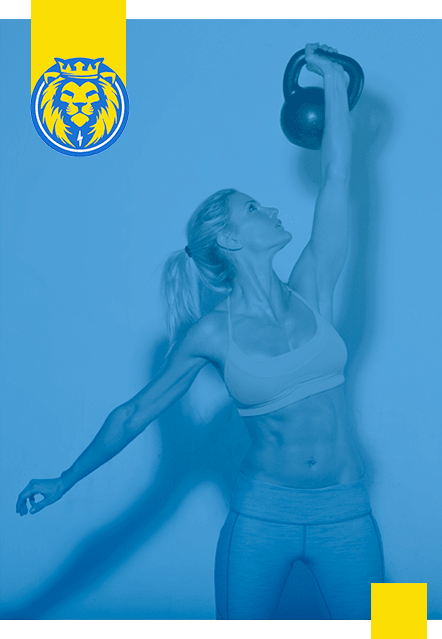
Fitness Myths
Due to popular media (magazines, internet, and fitness infomercials), it’s unfortunate that there are so many fallacies regarding fitness. What’s worse is that the common population is mislead, and these myths have become sort of accepted truths. As a result, people waste their time and money following non-evidenced based information leading to frustration and undesired outcomes. It is important to tell you the truth. It is my pleasure to debunk the myths you may read or believe so you can make better decisions about your health and how you invest your time.
Myth #1: “Weight training will make me big and bulky.”
The Truth:
- With respect to females, there is a lack of adequate testosterone, one of the key hormones responsible for an increase in muscle size and growth as compared to men.
- Females have 15-20 fold less testosterone than males.
- According to the Essentials of Strength and Conditioning, most females are not capable of an increase muscle size beyond 20%.
- It is highly unlikely without artificially-enhancing substances.
- If it occurs, it is a genetic oddity.
- With respect to males, it is extremely difficult to accomplish naturally despite adequate testosterone.
- One would have to train like a bodybuilder which is a livelihood.
- Professional bodybuilders are know to train 4-5 hours a day.
- Their focus is size and symmetry versus strength and function.
- If one consumes exogenous performance-enhancing (illegal) substances, then men can get achieve an increase in muscle size without an increase in strength.
- An increase in muscle size without an increase in strength will have a negative impact on the tendons supporting that muscle to the bone. Tendon strength is compromised without an accompanying or co-existing adaptation to strength. Tendons also adapt to stress from exercise. Tendons increase in diameter which increases their ability to withstand tension and tearing. Dr. Coleman, professor at the University of Houston Clear Lake puts it this way: “It’s like giving the muscles a strong rope to hang on.”
- Males have a genetically bounded upper limit of muscle growth.
- It is interesting to note that increases in cross sectional area of muscle fibers usually range from 20-40% in the majority of training studies.
- Few studies have found increases in muscle fiber size beyond this base level of change
Myth #2: “If I stop working out, my muscle will turn to fat.”
The Truth:
- Fat and muscle are two different types of tissue.
- It is physiologically impossible for a tissue to be converted into another type of tissue.
- Fat cells are called adipose tissue. This tissue will store fats from the diet if the fats being consumed are not needed as an energy source. Thus, the fat cells increase in size.
- Your body makes fat from excess food not just fat in the body. It is important to note, it’s not only dietary fat that becomes body fat: Extra nutrients of any kind has the potential to become “new” fat through a complex (7 step) process called fat synthesis.
- According to Dr. John Berardi of Precision Nutrition, fat synthesis typically occurs with a high sugar diet not a fatty diet.
Myth #3: “Stay in the fat burning zone if I want to lose body fat.”
The Truth:
- You will burn a larger percentage fat (versus carbohydrates) when training at a lower intensity (50—60% of target heart rate max)
- However, you will also burn fewer total calories and less total fat. For example: see chart below:
Bottom line: At the end of the workout, Option B burns more total calories from fat despite the lower percentage. 40 is greater than 30. Period. In my professional opinion, if you want to maintain your weight, stay in the fat burning zone. Sure, doing something is better than doing nothing, but why aim so low? Even if you are a beginner, you can do interval training. Interval training can simply be defined by alternating periods of work and rest. The intensity of the work interval will dictate the duration of the interval. There are a variety of strategies on how to implement interval training into your exercise program which are beyond the scope of this E-book.
It is interesting to note that innumerable scientific studies have demonstrated that more high intensity training be it aerobic or resistance training has more of an “after-burn” or what is known as as excess post oxygen consumption (EPOC). Without getting too detailed, this means that once you stop working out, the body is trying to restore itself back to the normal (pre-exercise) state. The energy being used after training is at a higher rate during this restoration. Thus, any physiological process in the body utilizing energy also needs to burn calories while doing it. Research suggests that high intensity, interval training has the most pronounced effect on EPOC like our metabolic training programs here at Pulse.
Myth #4: “Certain exercises will work my lower abs.”
The Truth:
- The rectus abdominus muscle (aka the 6 pack) is ONE muscle.
- The rectus abdominus muscles does not have an upper or lower division.
- Follows the “all or none” principle: Once recruited (stimulated), one can not train an upper or lower half of the RA muscle
- The nerve cell and all the fibers it innervates are called the motor unit.
- When a motor unit receives a signal, all the muscle fibers connected to the motor unit contract. This means once the nerve cell carries info from the brain to the muscle to contract, all the muscle fibers contract.
- Stu McGill, a renowned professor of spine biomechanics, states the following:
“A distinct upper and lower rectus abdominus does not exist in most people. Once force is required, the rectus appears to act as a cable with active tension along its entire length.”
- In contrast, this is not true for the obliques which have an upper, lower, medial, and lateral neural compartments.
- Some research studies claim (via electromyography, or EMG) that certain exercises can activate the lower portion of the rectus abdominus. However, professor McGill states, “There is a muscle called pyramidalis that can give different activation values.” The pyramidalis is an optional muscle meaning it is absent in about 20% of the population. It’s origin is anterior to the rectus abdominus and it inserts onto the linea alba (Netter, 2014).
- An interesting note: Stu McGill has seen separation in neural drive between upper and lower sections of the rectus abdominus in a few Middle Eastern belly dancers, but explains these abilities and moves are rare in every day life.
- A study in the Journal of Strength and Conditioning Research tested a variety of abdominal exercises
- Placed electrodes on upper and lower portion of rectus abdominus muscle
- Researchers measured electrical activity during each exercise
- Conclusion: There were no significant difference in amplitude of action potentials from the two sites
- Do you go by the “feel” test? Do you “feel” certain movements in the lower region of the abdominals?
- Certain movements can recruit the iliopsoas (a hip flexor) sometimes felt in the abdominals due to its origin point
Myth # 5: Lift light weights and do higher reps to tone my muscles.
The Truth:
This is one of the biggest lies in the fitness world. I am sorry to disappoint you if you believe this, but there is no such thing as muscle “tone.” There is no physiological adaptation to exercise that results in “tone.” It s a garbage term created by the uninformed and the uneducated.
Muscles either:
- atrophy (decrease in cross sectional area / size)
- hypertrophy (increase in cross sectional area / size)
- remain the same
- Light weight and high reps result in local muscular endurance (LME)
- Repeated contractions against low or moderate resistance in the working muscle
- > 12 repetition max
- Good for beginner
- Muscles do not magically change shapes due to a different rep and weight routine.
- If you want to see the shape of the musculature, one must have reduce the subcutaneous fat sitting on top of the muscle and decrease the fat in the muscle.
- In other words, reducing your body fat is key while developing more lean muscle mass via resistance training and eating clean.
Myth #6 Muscle weighs more than fat
The Truth:
- Muscle does not weigh more than fat
- They weigh the same
- Muscle is more dense or compact than fat
- Density is NOT the same as weight
- Density = mass/volume
- Muscle: 1.049grams/cc
- Fat: 0.918grams/c
- Muscle takes up less space
- Weight should not be the sole yardstick to measure progress
- The scale only tells you weight.
- The scale does not reveal fat-free mass vs. fat mass
- Body fat % is more important than weight
Raquel’s Take Away: Many fallacies about training are created from opinions and personal experiences. Unless you are reading a peer reviewed scientific journal, remain skeptical about the information you read in magazines, on the internet, and even certain books. Anyone can write a book today. I highly encourage to always look for credentials and seek evidence-based principles regarding training.

